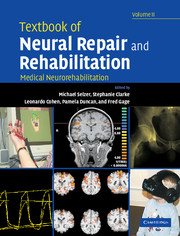Book contents
- Frontmatter
- Contents
- Preface
- Contributors
- Contributors
- Neural repair and rehabilitation: an introduction
- Section A Technology of neurorehabilitation
- Section A1 Outcomes measurement and diagnostic technology
- 1 Outcomes measurement: basic principles and applications in stroke rehabilitation
- 2 Human voluntary motor control and dysfunction
- 3 Assessments, interventions, and outcome measures for walking
- 4 Electromyography in neurorehabilitation
- 5 Functional neuroimaging
- Section A2 Therapeutic technology
- Section B Symptom-specific neurorehabilitation
- Section B1 Sensory and motor dysfunctions
- Section B2 Vegetative and autonomic dysfunctions
- Section B3 Cognitive neurorehabilitation
- Section C Disease-specific neurorehabilitation systems
- Index
- Plate section
2 - Human voluntary motor control and dysfunction
from Section A1 - Outcomes measurement and diagnostic technology
Published online by Cambridge University Press: 04 August 2010
- Frontmatter
- Contents
- Preface
- Contributors
- Contributors
- Neural repair and rehabilitation: an introduction
- Section A Technology of neurorehabilitation
- Section A1 Outcomes measurement and diagnostic technology
- 1 Outcomes measurement: basic principles and applications in stroke rehabilitation
- 2 Human voluntary motor control and dysfunction
- 3 Assessments, interventions, and outcome measures for walking
- 4 Electromyography in neurorehabilitation
- 5 Functional neuroimaging
- Section A2 Therapeutic technology
- Section B Symptom-specific neurorehabilitation
- Section B1 Sensory and motor dysfunctions
- Section B2 Vegetative and autonomic dysfunctions
- Section B3 Cognitive neurorehabilitation
- Section C Disease-specific neurorehabilitation systems
- Index
- Plate section
Summary
The ability to promote functional recovery after nervous system injury depends in part on understanding how the normal brain works and how the damaged brain reorganizes itself. This chapter discusses the current understanding of how areas of the cerebral cortex and their descending pathways contribute to voluntary motor control in humans in the context of how these areas may provide compensatory control for each other in the damaged brain. Primary motor cortical (M1) areas and non-primary motor cortical areas (NPMAs) are presented as a flexible control system for voluntary movement, with an inherent capacity for reorganization. In part, this capacity for flexible reorganization arises from the intrinsic organization of cortical areas, in part from the network of connections among areas, and in part from the availability of more than one descending pathway. The concluding section of this chapter discusses how, in addition to lesion size and lesion location, territories and tracts that are spared after a lesion can affect the capacity for functional recovery of movement.
The M1
The current view of M1 organization
Our thinking about M1 has been shaped largely by the oversimplification of two related concepts. First, the concept of motor somatotopy, which was carried farthest by the work of Penfield and his memorable cartoon, the homunculus (Penfield and Boldrey, 1937; Penfield and Rasmussen, 1950), has been interpreted to mean that different segments of the body are controlled from spatially separate regions of M1, down to the level of a different region for each finger of the hand.
Keywords
- Type
- Chapter
- Information
- Textbook of Neural Repair and Rehabilitation , pp. 24 - 36Publisher: Cambridge University PressPrint publication year: 2006
- 1
- Cited by

